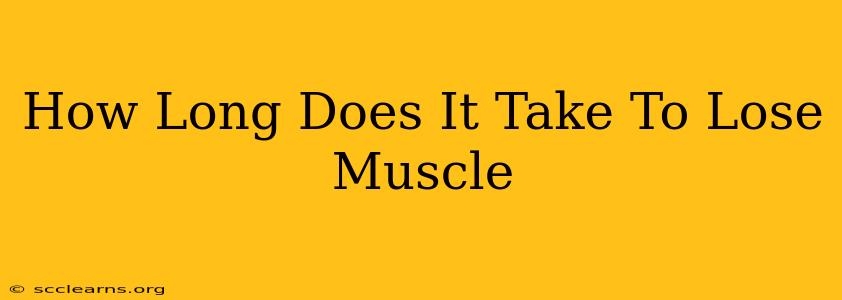Losing muscle mass, a process known as muscle atrophy, is a concern for many, whether due to injury, aging, or lifestyle changes. Understanding the timeframe and factors involved is crucial for maintaining muscle health and strength. This guide explores the timeline of muscle loss and how you can mitigate it.
How Quickly Does Muscle Loss Occur?
The rate at which you lose muscle depends on several key factors:
1. Age:
As we age, our bodies naturally produce less muscle protein, leading to a gradual decline in muscle mass – a process called sarcopenia. This typically begins around age 30, accelerating after age 50. While this is a natural process, it can be significantly slowed down with proper exercise and nutrition.
2. Activity Level:
Muscle atrophy happens faster in individuals leading sedentary lifestyles. The "use it or lose it" principle applies strongly here. Consistent strength training is vital for preventing muscle loss. If you suddenly stop exercising after a period of regular training, you'll see a noticeable decline in muscle mass within weeks.
3. Diet:
Insufficient protein intake directly impacts muscle maintenance and repair. Protein provides the building blocks for muscle tissue. A diet lacking in adequate protein will hinder your body's ability to rebuild and maintain muscle mass, leading to faster atrophy. Calorie restriction, especially when severe, can also accelerate muscle loss as the body utilizes muscle tissue for energy.
4. Health Conditions:
Certain medical conditions, such as cancer, diabetes, and chronic illnesses, can significantly accelerate muscle loss. Illnesses often lead to decreased appetite, reduced activity levels, and metabolic changes, all contributing to muscle atrophy.
The Timeline of Muscle Loss:
It's impossible to give a precise timeframe for muscle loss, as it varies greatly depending on the factors mentioned above. However, we can outline general possibilities:
-
Within Weeks (Inactive Individuals): Individuals who are already inactive and suddenly stop all strength training may experience noticeable muscle loss within a few weeks. Strength and size reductions will be evident.
-
Within Months (Moderately Active Individuals): Those who maintain a moderately active lifestyle but experience a significant reduction in activity may see a slower decline, typically over several months.
-
Gradual Loss (Active Individuals): For individuals who consistently engage in strength training and maintain a healthy diet, muscle loss will be a much slower, more gradual process.
How to Prevent Muscle Loss:
Fortunately, muscle loss isn't inevitable. These strategies can help you maintain or even build muscle mass:
-
Strength Training: Regular strength training is the most effective way to prevent muscle loss. Aim for at least two to three sessions per week, targeting all major muscle groups.
-
Protein Intake: Ensure you're consuming enough protein to support muscle repair and growth. Aim for at least 0.8 grams of protein per kilogram of body weight, or potentially more depending on your activity level.
-
Healthy Diet: Maintain a balanced diet rich in fruits, vegetables, and whole grains, in addition to adequate protein.
-
Stay Active: Even light activity, such as walking, can help prevent muscle loss and improve overall health.
In summary: The rate of muscle loss varies greatly depending on individual factors. By prioritizing strength training, maintaining a healthy diet, and staying active, you can significantly slow down and even reverse the process of muscle atrophy, ensuring you maintain strength and health for years to come.

